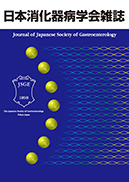
- Issue 4 Pages 251-
- Issue 3 Pages 161-
- Issue 2 Pages 77-
- Issue 1 Pages 1-
- |<
- <
- 1
- >
- >|
-
2024 Volume 121 Issue 3 Pages 161-166
Published: March 10, 2024
Released on J-STAGE: March 11, 2024
JOURNAL RESTRICTED ACCESSDownload PDF (389K)
-
Shinji TANAKA, Masahiro NAKAHARA, Wataru OKAMOTO2024 Volume 121 Issue 3 Pages 167-176
Published: March 10, 2024
Released on J-STAGE: March 11, 2024
JOURNAL RESTRICTED ACCESS
-
Takahisa MATSUDA, Masau SEKIGUCHI, Nozomu KOBAYASHI2024 Volume 121 Issue 3 Pages 177-185
Published: March 10, 2024
Released on J-STAGE: March 11, 2024
JOURNAL RESTRICTED ACCESS -
Naoya TOYOSHIMA, Yutaka SAITO2024 Volume 121 Issue 3 Pages 186-196
Published: March 10, 2024
Released on J-STAGE: March 11, 2024
JOURNAL RESTRICTED ACCESS -
Kay UEHARA, Takeshi YAMADA, Hiroshi YOSHIDA2024 Volume 121 Issue 3 Pages 197-203
Published: March 10, 2024
Released on J-STAGE: March 11, 2024
JOURNAL RESTRICTED ACCESS -
Kei MURO2024 Volume 121 Issue 3 Pages 204-211
Published: March 10, 2024
Released on J-STAGE: March 11, 2024
JOURNAL RESTRICTED ACCESS
-
Yuichi TAHARA, Akira HASHIMOTO, Hirono OWA, Takahiro ONO, Naoki KURODA ...2024 Volume 121 Issue 3 Pages 212-220
Published: March 10, 2024
Released on J-STAGE: March 11, 2024
JOURNAL RESTRICTED ACCESSA 59-year-old man presented to our hospital with a chief complaint of epigastric pain. Pertinent history included a distal gastrectomy for gastric cancer and alcohol dependence. He underwent contrast-enhanced computed tomography (CT) and esophagogastroduodenoscopy, which led to a diagnosis of esophageal cancer (cT2N2M1, stage IVb). Subsequently, he underwent chemotherapy using 5-fluorouracil and cis-diamminedichloroplatinum and radiotherapy. A total of 44 days after treatment initiation, the patient experienced nausea and hepatobiliary enzyme elevation. CT and abdominal ultrasonography were performed, and he was diagnosed with an abdominal aortic thrombus. Intravenous heparin was administered as an anticoagulant therapy. Twenty-two days after treatment initiation, the thrombus was no longer visible on abdominal ultrasonography. The patient was then treated with warfarin. It cannot be ruled out that the patient's hepatobiliary enzyme elevation was induced by the anticancer drugs. However, enzyme elevation improved with the disappearance of the abdominal aortic thrombus, suggesting that the aortic thrombus may have contributed to the hepatobiliary enzyme elevation. No thrombus recurrence was observed until the patient's death after an initial treatment with antithrombotic agents. This case indicates that malignant tumors and chemotherapy can cause aortic thrombi, and thus, care should be exercised in monitoring this potential complication.
View full abstractDownload PDF (1186K) -
Yasuhiro OKA, Yukako HAMANO, Ryo NAKAMURA, Keisuke MABUCHI, Masanori O ...2024 Volume 121 Issue 3 Pages 221-229
Published: March 10, 2024
Released on J-STAGE: March 11, 2024
JOURNAL RESTRICTED ACCESSWith the advent of immune checkpoint inhibitors (ICI), cancer treatment options have widened in recent years. However, ICI-specific adverse events (irAEs) have been reported. Lower gastrointestinal lesions, such as colitis and enteritis, account for most gastrointestinal irAEs, and reports of upper gastrointestinal lesions are rare. We report a rare case of gastroesophagitis associated with ICI. The patient was a 64-year-old male. He was diagnosed with lung adenocarcinoma stage IIIB (cT2aN3M0), and pembrolizumab (PEM) was started as a first-line treatment. Severe gastroesophagitis with laryngopharyngitis was confirmed 5 months after PEM administration. These improved after withdrawal of PEM and steroid administration. Reports of ICI-associated gastritis remain limited, especially with laryngopharyngitis;therefore, we consider this case as valuable, in which we confirmed the clinical features of ICI-associated gastroesophagitis and its therapeutic effects.
View full abstractDownload PDF (1388K) -
Sen YAGI, Hidehiro MURAKAMI, Junichirou TAMAI, Kazuki MURAKAMI, Makoto ...2024 Volume 121 Issue 3 Pages 230-236
Published: March 10, 2024
Released on J-STAGE: March 11, 2024
JOURNAL RESTRICTED ACCESSA 40-year-old woman was admitted to our hospital by ambulance due to accidental ingestion of 100ml of 35% hydrogen peroxide. Although the patient suffered from frequent vomiting, abdominal distension, and abdominal pain, signs of peritonitis were not observed. An abdominal computed tomography examination demonstrated obvious gas images in the gastric wall and intrahepatic portal veins. Upper gastrointestinal endoscopy revealed mucosal redness, swelling, and erosion from the lower part of the esophagus to the duodenum. Portal venous gas and upper gastrointestinal mucosal injury due to accidental hydrogen peroxide ingestion were suspected. As the vital signs were stable and there were no signs peritoneal irritation or neurological symptoms, she was treated medically with vonoprazan, rebamipide, and sodium alginate. The next day, abdominal symptoms immediately improved and 3 days later, hepatic portal venous gas had disappeared on ultrasonography. She was discharged on the 5th day after admission. Two months later, upper gastrointestinal endoscopy showed improvement in inflammatory findings. We report a remarkable case of hepatic portal venous gas and upper gastrointestinal mucosal injury and elucidate the endoscopic findings associated with hydrogen peroxide ingestion.
View full abstractDownload PDF (1083K) -
Kazuya MIZUTA, Futa KOGA, Yuka KAWAZOE, Kenichiro MURAYAMA, Shunya NAK ...2024 Volume 121 Issue 3 Pages 237-244
Published: March 10, 2024
Released on J-STAGE: March 11, 2024
JOURNAL RESTRICTED ACCESSA woman in her 70s was hospitalized and was diagnosed with liver abscess and managed with antibiotics in a previous hospital. However, she experienced altered consciousness and neck stiffness during treatment. She was then referred to our hospital. On investigation, we found that she had meningitis and right endophthalmitis concurrent with a liver abscess. Klebsiella pneumoniae was detected from both cultures of the liver abscess and effusion from the cornea. A string test showed a positive result. Therefore, she was diagnosed with invasive liver abscess syndrome. Although she recovered from the liver abscess and meningitis through empiric antibiotic treatment, her right eye required ophthalmectomy. In cases where a liver abscess presents with extrahepatic complications, such as meningitis and endophthalmitis, the possibility of invasive liver abscess syndrome should be considered, which is caused by a hypervirulent K. pneumoniae.
View full abstractDownload PDF (795K)
-
2024 Volume 121 Issue 3 Pages 249
Published: March 10, 2024
Released on J-STAGE: March 11, 2024
JOURNAL RESTRICTED ACCESSDownload PDF (68K)
- |<
- <
- 1
- >
- >|